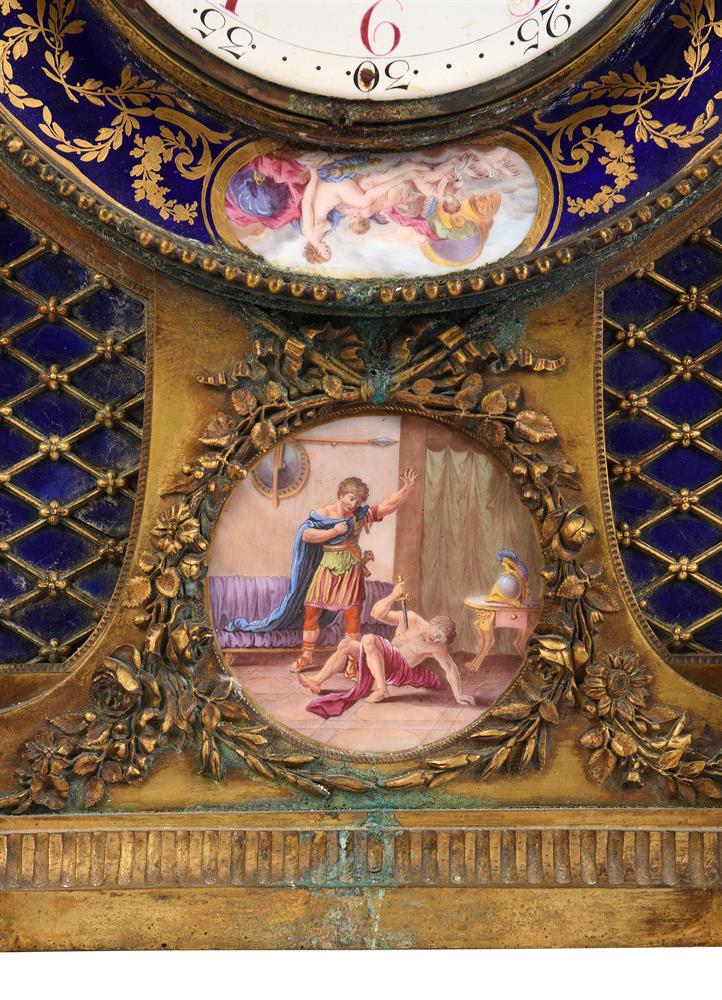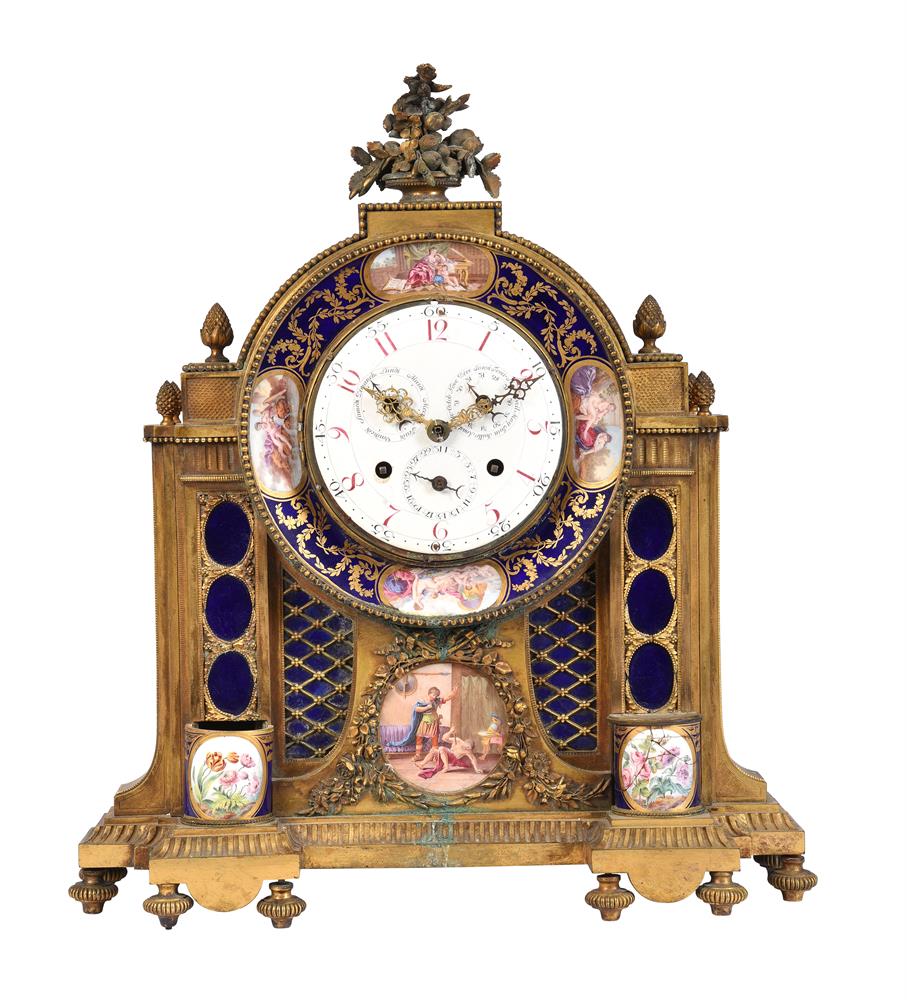A fine and unusual Scottish George II mahogany and burr elm domestic striking regulator of one week duration with centre seconds Alexander Cumming, Inveraray, circa 1755 The substantial five pillar rack striking movement with deadbeat escapement regulated by a later seconds period wood rod 'Ludlam' pendulum with heavy brass faced lenticular bob, bolt-and-shutter maintaining power and six wheel going train, the backplate with aperture cut for the pallets, the 12 inch square single sheet silvered brass Roman numeral dial with blued steel hands and signed Ale:r Cumming INVERARAY to an arched cartouche to centre within chapter ring with Arabic five minutes to outer track and fine scallop shell inhabited foliate scroll engraved decoration to spandrels, in a case with complex moulded dentil cornice, fretwork frieze and turned three-quarter columns to the hood door, the sides with break-arch glazed apertures and quarter columns applied to bargeboards at the rear, the trunk with convex throat over burr elm veneered panel inset break-arch door, the plinth base veneered with conforming rectangular panel over ogee bracket feet, 207cm (81.5ins) high. Provenance: Possibly constructed for Archibald Campbell the third Duke of Argyll, whilst the maker was working for him at Inveraray circa 1755. Alexander Cumming was born circa 1732 and is believed to have been apprenticed to an Edinburgh based watchmaker. At an early stage his talent for the mechanical was noticed by Lord Milton through whom he is most likely to have ended up working alongside his brother, James, at Inveraray for Archibald Campbell the third Duke of Argyll during the 1750's. Alexander and James Cumming were commissioned by the Duke to install an organ for his new castle at Inveraray and Alexander was also tasked to produce a clock. Alexander Cumming was a founder member of the Scottish Royal Society in Edinburgh and by 1761 (after the death of Archibald Campbell he had moved to London possibly through the encouragement of Thomas Grignon. By 1763 Cumming was established in New Bond Street and supplied the first ever recording barometer to George III which is still in the Royal Collection at Buckingham Palace. He was subsequently appointed as an 'expert' by Act of Parliament to assess Harrison's marine timekeepers and in 1766 he published The Elements of Clock and Watch Work. In addition to clockmaking Cumming is also credited with other notable inventions such as the first accurate recording barograph (1766), the microtome - a machine for making extremely thin slices as used in microscope slide-preparation (1770) and an advanced design of flushing toilet which included a trap to prevent odours re-entering the room. By the mid 1790's Alexander Cumming had retired to Penton Place in Pentonville, then a suburb of London, where he wrote a number of essays on mechanical questions. He died at home on 8th March 1814, aged eighty-two, and was buried at St James's Chapel, Pentonville Road, Finsbury, London. The current lot is an interesting and potentially historically significant example of Cumming's early work due to being distinctly experimental in nature and dating to his time at Inveraray. The escapement is perhaps particularly noteworthy as it appears to follow a design by Thomas Grignon which was conceived as an improvement over Graham's deadbeat (see Rees, Abraham Rees's Clocks Watches and Chronometers 1819-20 page 200 and Fig 6). If this is the case then evidence of collaboration between Grignon and Cumming would serve as confirmation of a direct connection with Archabold Campbell due to the fact that the third Duke also commissioned Grignon to produce a clock for presentation to the Royal Society of Arts in London (also see Rees, page 68). The six-wheel going train is unusual but was probably necessary in a hour-striking clock that was also intended to serve as an accurate timepiece and possible 'test bed' for an improved design of deadbeat escapement. It would seem that
A fine and unusual Scottish George II mahogany and burr elm domestic striking regulator of one week duration with centre seconds Alexander Cumming, Inveraray, circa 1755 The substantial five pillar rack striking movement with deadbeat escapement regulated by a later seconds period wood rod 'Ludlam' pendulum with heavy brass faced lenticular bob, bolt-and-shutter maintaining power and six wheel going train, the backplate with aperture cut for the pallets, the 12 inch square single sheet silvered brass Roman numeral dial with blued steel hands and signed Ale:r Cumming INVERARAY to an arched cartouche to centre within chapter ring with Arabic five minutes to outer track and fine scallop shell inhabited foliate scroll engraved decoration to spandrels, in a case with complex moulded dentil cornice, fretwork frieze and turned three-quarter columns to the hood door, the sides with break-arch glazed apertures and quarter columns applied to bargeboards at the rear, the trunk with convex throat over burr elm veneered panel inset break-arch door, the plinth base veneered with conforming rectangular panel over ogee bracket feet, 207cm (81.5ins) high. Provenance: Possibly constructed for Archibald Campbell the third Duke of Argyll, whilst the maker was working for him at Inveraray circa 1755. Alexander Cumming was born circa 1732 and is believed to have been apprenticed to an Edinburgh based watchmaker. At an early stage his talent for the mechanical was noticed by Lord Milton through whom he is most likely to have ended up working alongside his brother, James, at Inveraray for Archibald Campbell the third Duke of Argyll during the 1750's. Alexander and James Cumming were commissioned by the Duke to install an organ for his new castle at Inveraray and Alexander was also tasked to produce a clock. Alexander Cumming was a founder member of the Scottish Royal Society in Edinburgh and by 1761 (after the death of Archibald Campbell he had moved to London possibly through the encouragement of Thomas Grignon. By 1763 Cumming was established in New Bond Street and supplied the first ever recording barometer to George III which is still in the Royal Collection at Buckingham Palace. He was subsequently appointed as an 'expert' by Act of Parliament to assess Harrison's marine timekeepers and in 1766 he published The Elements of Clock and Watch Work. In addition to clockmaking Cumming is also credited with other notable inventions such as the first accurate recording barograph (1766), the microtome - a machine for making extremely thin slices as used in microscope slide-preparation (1770) and an advanced design of flushing toilet which included a trap to prevent odours re-entering the room. By the mid 1790's Alexander Cumming had retired to Penton Place in Pentonville, then a suburb of London, where he wrote a number of essays on mechanical questions. He died at home on 8th March 1814, aged eighty-two, and was buried at St James's Chapel, Pentonville Road, Finsbury, London. The current lot is an interesting and potentially historically significant example of Cumming's early work due to being distinctly experimental in nature and dating to his time at Inveraray. The escapement is perhaps particularly noteworthy as it appears to follow a design by Thomas Grignon which was conceived as an improvement over Graham's deadbeat (see Rees, Abraham Rees's Clocks Watches and Chronometers 1819-20 page 200 and Fig 6). If this is the case then evidence of collaboration between Grignon and Cumming would serve as confirmation of a direct connection with Archabold Campbell due to the fact that the third Duke also commissioned Grignon to produce a clock for presentation to the Royal Society of Arts in London (also see Rees, page 68). The six-wheel going train is unusual but was probably necessary in a hour-striking clock that was also intended to serve as an accurate timepiece and possible 'test bed' for an improved design of deadbeat escapement. It would seem that








.jpg)


.jpg)
.jpg)
.jpg)
.jpg)
Try LotSearch and its premium features for 7 days - without any costs!
Be notified automatically about new items in upcoming auctions.
Create an alert